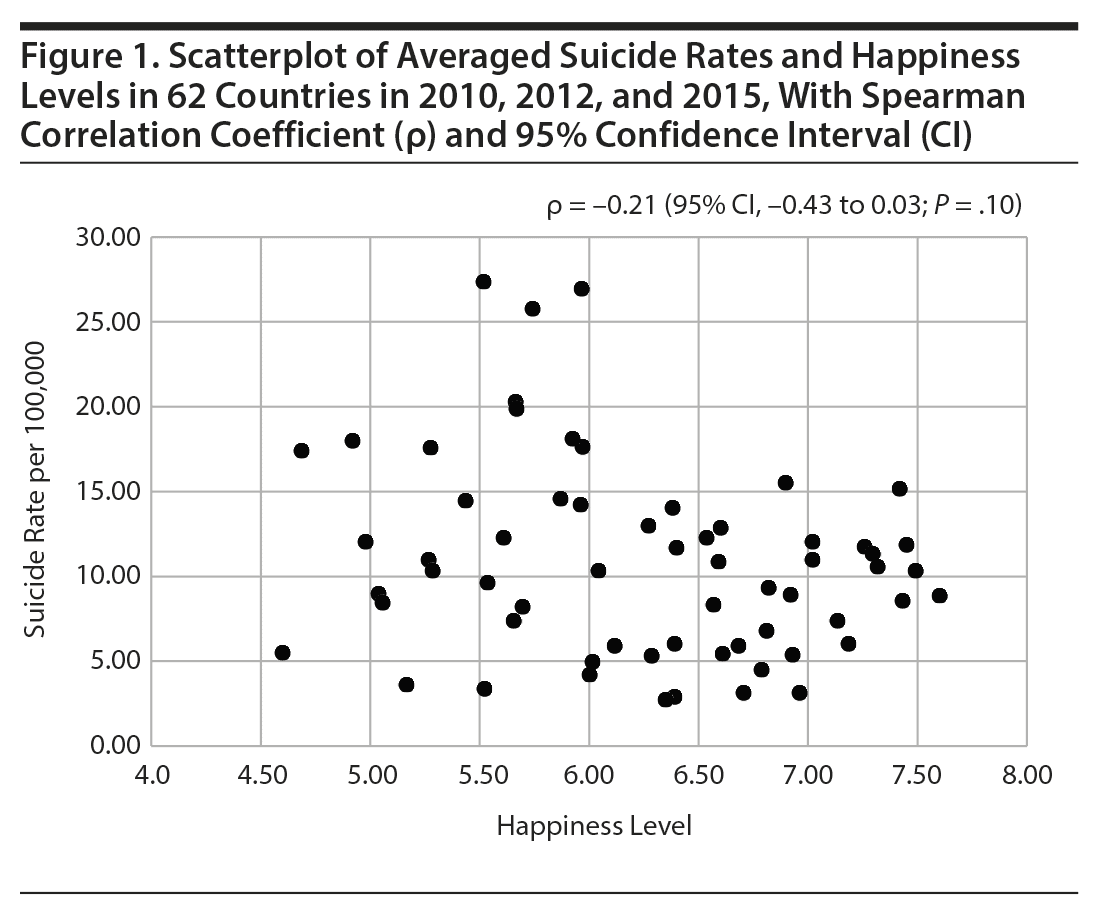
Suicide rates are one of the key indicators used to monitor population mental health in the United Nations’ Sustainable Development Goals (SDGs). The Lancet Commission on Global Mental Health1 and Sustainable Development Report 20192 recently proposed that subjective well-being (measured using a questionnaire-based measure of happiness) could be an additional indicator of mental health in the SDGs. However, the extent to which happiness taps into a different component of mental health compared to suicide is understudied at the population level. In one recent study, the association between suicide and happiness across communities in Hong Kong was largely explained by their close relationships with socioeconomic factors3; likewise, any association between national suicide rates and happiness could be due to shared socioeconomic influences on both of these measures. Furthermore, the suicide-happiness relationship may differ in countries with different levels of socioeconomic development.4 This study examined the cross-national relationship between countries’ suicide rates and happiness levels.
Methods
Data. Suicide rate data were from the World Health Organization’s Statistics databases.5,6 Happiness data were from the World Happiness Report 2019 published by the United Nations Sustainable Development Solutions Network.7 Complete data for both suicide and happiness were available for 2010, 2012, and 2015. The United Nations’ Human Development Index (HDI) measures the socioeconomic circumstances of each country across 3 dimensions—health, education, and standard of living.8 Countries with the highest-quality suicide data5 or a very high HDI were included in the main analysis (n = 62; referred to as countries with high-quality suicide data for simplicity) to ensure that high-quality data were analyzed (data available from the authors upon request). Data for all countries with available data for suicide and happiness (n = 122) were used in the sensitivity analysis.
Statistical analysis. Averaged suicide rates and happiness levels in the 3 study years were calculated. Spearman rank correlation coefficients (Ï) with 95% confidence intervals (CIs) were computed to assess the association between suicide and happiness. Partial correlation was calculated to investigate the potential confounding effect of HDI. Correlation analyses stratified by HDI level were conducted using the median of HDI as the cutoff point, and the difference in correlation coefficients between lower and higher HDI countries was examined using Fisher Z score.9
Results
There was no statistical evidence for a correlation between suicide and happiness (ρ = −0.21; 95% CI, −0.43 to 0.03; P = .10) in the 62 countries with high-quality suicide data (Figure 1). After controlling for HDI, there was a weak inverse association between suicide and happiness in these countries (ρ = −0.34; 95% CI, −0.55 to −0.10; P = .008); countries with higher happiness scores had lower suicide rates. Happiness was moderately correlated with HDI (ρ = 0.56; 95% CI, 0.33 to 0.73; P < .001), while there was little evidence for a correlation between suicide and HDI (ρ = 0.13; 95% CI, −0.12 to 0.33; P = .33). When stratifying by HDI, there was no correlation between suicide and happiness (ρ = −0.08; 95% CI, −0.45 to 0.31; P = .70) in countries with a higher HDI (n = 31), while there was a moderate negative correlation (ρ = −0.43; 95% CI, −0.69 to – 0.07; P = .02) in countries with a lower HDI (n = 31), although there was no statistical evidence for a difference in lower and higher HDI countries (P = .17). Sensitivity analyses including all countries with available data (n = 122) showed a similar pattern of correlations between suicide, happiness, and HDI as that among the 62 countries included in the main analysis.
Discussion
Both suicide and happiness may be appropriate indicators for mental health in the SDGs as they appear to measure different aspects of mental health—happiness could be a measure of the population’s well-being and is related to a country’s development level, while suicide rate is a measure of the population’s suffering at the extreme low end and does not appear to be related to a country’s development level. The weak association between suicide rates and happiness could also be because factors other than mental health may affect suicide rates, such as access to lethal means (eg, firearms in the US), media reporting of suicide, and levels of alcohol misuse.10
This is the first global assessment of the association between countries’ suicide rates and populations’ happiness. Some limitations need to be considered. First, our main analysis was limited to countries with reliable suicide data, which were mostly high development level countries. Second, there could be factors that lead to differences in measuring national happiness level such as sampling, response rates, and cultural influences on interpreting questions. Third, we did not investigate other important factors that may underlie the suicide-happiness association such as the prevalence of mental disorders because data were unavailable.
Published online: September 15, 2020.
Author contributions: Drs Hsu and Chang had full access to all of the data in the study and take responsibility for the integrity of the data and the accuracy of the data analysis. Study concept and design: all authors. Acquisition, analysis, or interpretation of data: all authors. Drafting of the manuscript: all authors. Critical revision of the manuscript for important intellectual content: all authors. Statistical analysis: Dr Hsu. Administrative, technical, or material support: Drs Hsu and Chang. Study supervision: Dr Chang.
Potential conflicts of interest: None reported.
Funding/support: This study was not funded. Dr Hsu was supported by a grant from Wan Fang Hospital (109-wf-swf-04). Dr Chang was supported by a grant from National Taiwan University (NTU-CDP-108L7708 and NTUCC-109L891503). Dr Gunnell is supported by the National Institute for Health Research Biomedical Research Centre at University Hospitals Bristol NHS Foundation Trust and the University of Bristol.
Role of the sponsor: The sponsors had no role in the design and conduct of the study; collection, management, analysis, and interpretation of the data; preparation, review, or approval of the manuscript; or the decision to submit the manuscript for publication.
Disclaimer: The views expressed in this correspondence are those of the authors and not necessarily those of the National Health Service, the National Institute for Health Research, or the Department of Health and Social Care.
REFERENCES
1.Patel V, Saxena S, Lund C, et al. The Lancet Commission on global mental health and sustainable development. Lancet. 2018;392(10157):1553-1598. PubMed CrossRef
2.Sachs J, Schmidt-Traub G, Kroll C, et al. Sustainable Development Report 2019. New York, NY: Sustainable Development Solutions Network; 2019.
3.Hsu CY, Chang SS, Yip PSF. Subjective wellbeing, suicide and socioeconomic factors: an ecological analysis in Hong Kong. Epidemiol Psychiatr Sci. 2019;28(1):112-130. PubMed CrossRef
4.Bray I, Gunnell D. Suicide rates, life satisfaction and happiness as markers for population mental health. Soc Psychiatry Psychiatr Epidemiol. 2006;41(5):333-337. PubMed CrossRef
5.World Health Organization. Preventing Suicide: A Global Imperative. Geneva, Switzerland: World Health Organization; 2014.
6.Global Health Observatory (GHO) data. World Health Organization website. https://www.who.int/gho/en/. 2018. Cited May 28, 2020.
7.Helliwell J, Layard R, Sachs J. World Happiness Report 2019. New York, NY: Sustainable Development Solutions Network; 2019.
8.The United Nations Development Programme. Human Development Report 2019. New York, NY: The United Nations Development Programme; 2019.
9.Sheskin D. Handbook of Parametric and Nonparametric Statistical Procedures. 5th ed. Boca Raton, FL: CRC Press; 2011.
10.Turecki G, Brent DA, Gunnell D, et al. Suicide and suicide risk. Nat Rev Dis Primers. 2019;5(1):74. PubMed CrossRef
aDepartment of Psychiatry, Wan Fang Hospital, Taipei Medical University, Taipei City, Taiwan
bPsychiatric Research Center, Wan Fang Hospital, Taipei Medical University, Taipei City, Taiwan
cDepartment of Psychiatry, School of Medicine, College of Medicine, Taipei Medical University, Taipei City, Taiwan
dInstitute of Health Behaviors and Community Sciences, and Department of Public Health, College of Public Health, National Taiwan University, Taipei City, Taiwan
eBristol Medical School, Population Health Sciences, University of Bristol, Bristol, United Kingdom
fNational Institutes of Health Research Biomedical Research Centre at the University Hospitals Bristol and Weston NHS Foundation Trust and the University of Bristol, Bristol, United Kingdom
*Corresponding author: Shu-Sen Chang, PhD, Institute of Health Behaviors and Community Sciences, and Department of Public Health, College of Public Health, National Taiwan University, 17 Xu-Zhou Road, Taipei City 100, Taiwan ([email protected]).
J Clin Psychiatry 2020;81(6):20l13339
To cite: Hsu CY, Chang SS, Gunnell D. Suicide and happiness: the association between two potential Sustainable Development Goal indicators for mental health. J Clin Psychiatry. 2020;81(6):20l13339.
To share: https://doi.org/10.4088/JCP.20l13339
© Copyright 2020 Physicians Postgraduate Press, Inc.
This PDF is free for all visitors!






